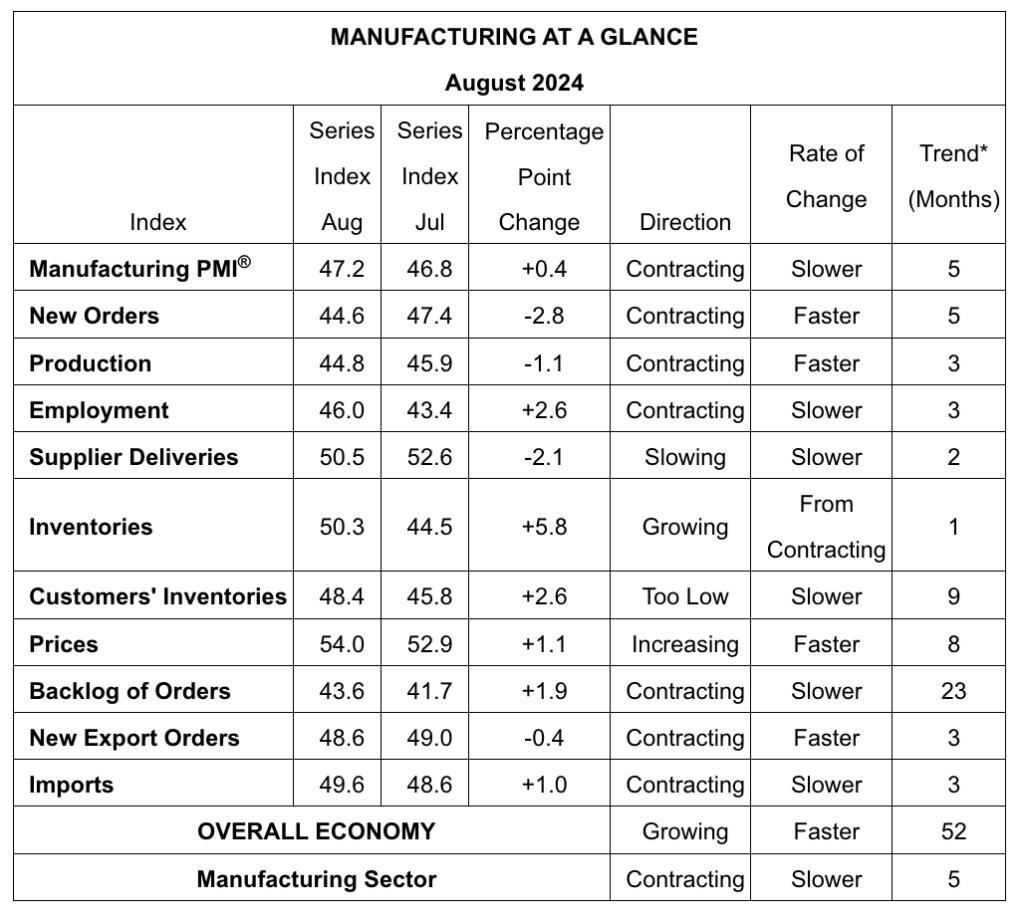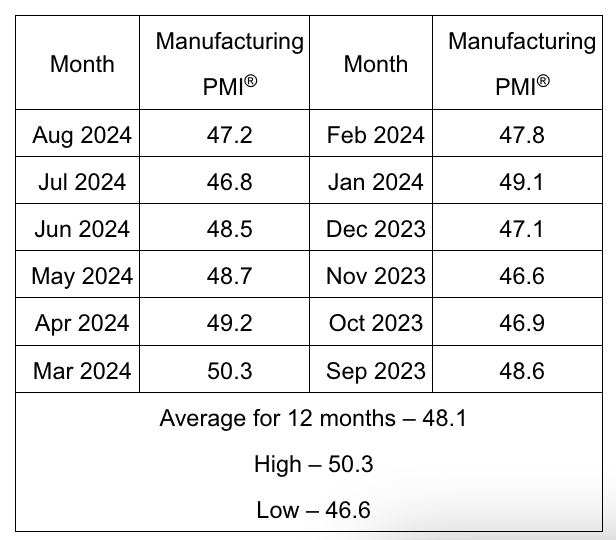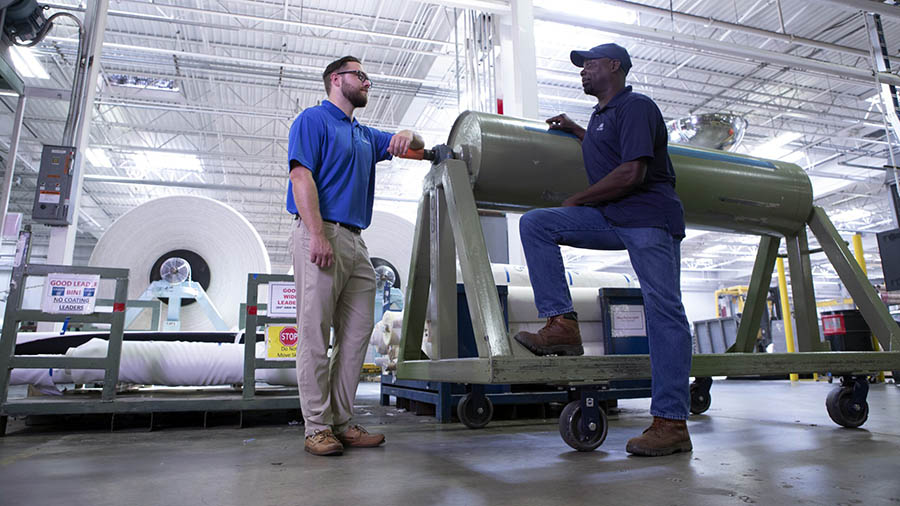A recently released report from Timothy R. Fiore, CPSM, C.P.M., chair of the Institute for Supply Management (ISM) Manufacturing Business Survey Committee, sounded another alarm that the U.S. manufacturing sector contracted in August for the fifth consecutive month and the 21st time in the last 22 months.
“The Manufacturing PMI registered 47.2 percent in August, up 0.4 percentage point from the 46.8 percent recorded in July,” Fiore highlighted. “The overall economy continued to expand for the 52nd month after one month of contraction in April 2020. The New Orders Index remained in contraction territory, registering 44.6 percent, 2.8 percentage points lower than the 47.4 percent recorded in July.”
- The reading of August’s Production Index (44.8 percent) found it to be 1.1 percentage points lower than July’s figure of 45.9 percent.
- The Prices Index registered 54 percent, up 1.1 percentage points from the July reading of 52.9 percent.
- The Backlog of Orders Index registered 43.6 percent, up 1.9 percentage points compared to 41.7 in July.
- The Employment Index registered 46 percent, up 2.6 percentage points from July’s figure of 43.4 percent.
Fiore noted that a Manufacturing PMI above 42.5 percent over some time generally indicates an expansion of the overall economy.
“The Supplier Deliveries Index indicated slowing deliveries, registering 50.5 percent, 2.1 percentage points lower than the 52.6 percent recorded in July. (Supplier Deliveries is the only ISM Report On Business Index that is inversed. A reading above 50 percent indicates slower deliveries, typical as the economy improves and customer demand increases.) The Inventories Index registered 50.3 percent, up 5.8 percentage points compared to July’s reading of 44.5 percent,” Fiore continued.
The New Export Orders Index reading of 48.6 percent is 0.4 percentage points lower than the 49 percent registered in July. The Imports Index remained in contraction territory in August, registering 49.6 percent, 1 percentage point higher than the 48.6 percent reported in July,” he said.
 Fiore continued, “While still in contraction territory, U.S. manufacturing activity contracted slower compared to last month. Demand continues to be weak, output declined,and inputs stayed accommodative. Demand slowing was reflected by the (1) New Orders Index dropping further into contraction, (2) New Export Orders Index contracting slightly faster, (3) Backlog of Orders Index remaining in strong contraction territory, and (4) Customers’ Inventories Index at the ‘just right’ level. (For more, see the Customers’ Inventories Index summary below.) Output (measured by the Production and Employment indexes) continued in moderate contraction with production sagging further, while employment contracted slower as compared to July. Panelists’ companies reduced production levels month over month as head-count reductions continued in August. Inputs — defined as supplier deliveries, inventories, prices and imports — generally continued to accommodate future demand growth, with inventory growth attributed to a supply demand timing mismatch.
Fiore continued, “While still in contraction territory, U.S. manufacturing activity contracted slower compared to last month. Demand continues to be weak, output declined,and inputs stayed accommodative. Demand slowing was reflected by the (1) New Orders Index dropping further into contraction, (2) New Export Orders Index contracting slightly faster, (3) Backlog of Orders Index remaining in strong contraction territory, and (4) Customers’ Inventories Index at the ‘just right’ level. (For more, see the Customers’ Inventories Index summary below.) Output (measured by the Production and Employment indexes) continued in moderate contraction with production sagging further, while employment contracted slower as compared to July. Panelists’ companies reduced production levels month over month as head-count reductions continued in August. Inputs — defined as supplier deliveries, inventories, prices and imports — generally continued to accommodate future demand growth, with inventory growth attributed to a supply demand timing mismatch.
“Demand remains subdued, as companies show an unwillingness to invest in capital and inventory due to current federal monetary policy and election uncertainty. Production execution was down compared to July, putting additional pressure on profitability. Suppliers continue to have capacity, with lead times improving and shortages not as severe. Sixty-five percent of manufacturing gross domestic product (GDP) contracted in August, down from 86 percent in July. The share of manufacturing sector GDP registering a composite PMI calculation at or below 45 percent (a good barometer of overall manufacturing weakness) was 33 percent in August, a 20-percentage point improvement compared to the 53 percent reported in July. Two of the six of the largest manufacturing industries — Food, Beverage & Tobacco Products; and Computer & Electronic Products — expanded in August, compared to none in July,” said Fiore.
Gainers and Decliners
The five manufacturing industries reporting growth in August are Primary Metals, Petroleum & Coal Products, Furniture & Related Products, Food, Beverage & Tobacco Products, and Computer & Electronic Products.
The 12 industries reporting contraction in August (in the following order) areTextile Mills, Printing & Related Support Activities, Nonmetallic Mineral Products, Plastics & Rubber Products, Electrical Equipment, Appliances & Components, Fabricated Metal Products, Transportation Equipment, Wood Products, Machinery, Paper Products, Chemical Products, and Miscellaneous Manufacturing.
“The past relationship between the Manufacturing PMI and the overall economy indicates that the August reading (47.2 percent) corresponds to a change of plus-1.3 percent in real gross domestic product (GDP) on an annualized basis,” said Fiore.
Trailing 12-Month Manufacturing PMI

Image courtesy Milliken















